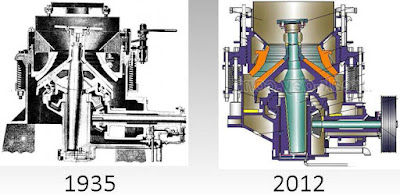Last month's Comminution '16 highlighted the many innovations that are taking place in comminution, the most important, yet the most energy intensive, area of the mineral processing flowsheet.
Grinding is evolving and changing fast, with innovations in high pressure grinding rolls and stirred mills threatening to make the tumbling mill, which has been a stalwart for well over a century, obsolete.
But innovation in crushing has not been so rapid, and most of the developments reported in this area have been in control, simulation and optimisation of crushing circuits, rather than in new developments in the machines themselves. Indeed only two years ago, at Comminution '14, Tim Napier-Munn in his keynote lecture observed that in the 1970s Professor Klaus Schonert showed that the most energy-efficient way to break a rock was to place it between two opposed platens and load it until it fractured in tension, this simple mechanism seriously limiting the options regarding real innovation in the comminution process. To support this view he showed a slide of one of today’s cone crushers showing that in all material respects it is identical to a cone crusher manufactured in the 1930s.
So it was good to see new developments in crushers on display last month. South African company Crush Force was promoting a radically new energy efficient and cost effective development in cone crusher design, departing from the traditional stationary concave and moving mantle. They claim that the new development removes the complex drive systems entering the machine from the bottom, and offers a simpler more robust solution, and due to the higher pressures and greater range of movement possible in the crushing chamber of this design many options are opened up that are not available on traditional designs. Reduction ratios are much higher which opens up a vast field of applications that could never be achieved with cone crushers before.
 |
| Demonstration of the new Crush Force cone crusher |
Also on display was the EDS multi-shaft mill, a novel device combining a series of rotating shafts with attached flingers which impact gravity fed material. Currently the mill is at pilot plant scale operating with a F80 below 40 mm and milling up to 80 tph, depending on ore type. A 1:4 scale model of the 10 shaft mill was on view, showing how the milling action combines a number of processes to provide an output product to match various specifications.
 |
| The EDS pilot scale mill |
I am sure that we will hear and see more of these and other innovative devices at Comminution '18. It would also be good to hear more of a novel device, which I had not heard of before I saw a recent article in Australian Mining.
The IMPTEC Super Fine Crusher, invented by Chris Kelsey of IMP Technology, is claimed to be able to produce fine particles under dramatically reduced energy use. Apparently the crusher can crush materials of almost any hardness including zircon, quartz or garnet, in the range D50 of 5 microns, media free, in a wet or dry environment, making it unique and highly desirable for industrial mineral industries across the globe.
The crusher has gone through a number of adaptations to be scaled up and tested in trials at Hallett Concrete in South Australia. Supporters of the project include the South Australian government’s Mining Industry Participation Office and several mining and quarrying companies operating in South Australia, who agree the technology is set to change the industry across the globe with huge implications on costs and productivity, if it proves successful in a commercial setting. IMP Technology managing director and CEO John Doherty said the team was passionately dedicated to the project and excited about the prospect of exporting their technology to the world. Comminution '18 would be an ideal place to showcase it!
Twitter @barrywills


.png)




.jpg)
.png)












It is very interesting. It is good that more attention is being given to machine developments than theories of comminution.
ReplyDeleteRao,T.C.
Hi Barry. Chris Kelsey's Superfine Crusher also recently won a South Australian Resources Innovation Award. I've seen the "beast" in operation and we have looked at its performance. They will be presenting at IMPC 2016 this year. Robin Batterham, the former Australian Chief Scientist gave a presentation at INERMA in Istanbul in October last year. The technology has great potential in primary or regrind. Can take 10 mm down to <10 um in the one unit. Scale up is the challenge. Cheers. Bill
ReplyDeleteThe United Kingdom is in the process of investing a huge amount of money in new waste management facilities now and over the next five years. However, much of the money is going into incineration schemes to divert biodegradable municipal waste (BMW) away from landfills, after a high degree of sorting and recycling. Many have been critical of that trend. The new waste technologies should be an option to replace incineration, but are only feasible after considering the difficulties faced by waste managers in promoting the new comliant alternatives. Read this article to understand why!
ReplyDelete